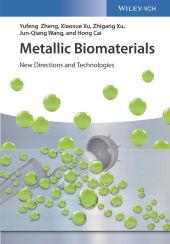 Neuerscheinungen 2017Stand: 2020-02-01 |
Schnellsuche
ISBN/Stichwort/Autor
|
Herderstraße 10
10625 Berlin
Tel.: 030 315 714 16
Fax 030 315 714 14
info@buchspektrum.de |

Xiaoxue Xu, Zhigang Xu, Yufeng Zheng
(Beteiligte)
Metallic Biomaterials
New Directions and Technologies
1. Auflage. 2017. XIV S. 25 SW-Abb., 18 Farbabb., 31 Tabellen. 244 mm
Verlag/Jahr: WILEY-VCH 2017
ISBN: 3-527-34126-9 (3527341269)
Neue ISBN: 978-3-527-34126-9 (9783527341269)
Preis und Lieferzeit: Bitte klicken
With its comprehensive coverage of recent progress in metallic biomaterials, this reference focuses on emerging materials and new biofunctions for promising applications.
The text is systematically structured, with the information organized according to different material systems, and concentrates on various advanced materials, such as anti-bacterial functionalized stainless steel, biodegradable metals with bioactivity, and novel structured metallic biomaterials. Authors from well-known academic institutes and with many years of clinical experience discuss all important aspects, including design strategies, fabrication and modification techniques, and biocompatibility.
Chapter 1. Introduction
1.1. Traditional metallic biomaterials
1.2. Revolutionizing metallic biomaterials and their new biofunctions
1.2.1. What are the revolutionizing metallic biomaterials?
1.2.2. Antibacterial function
1.2.3. Promotion of osteogenesis
1.2.4. Reduction of in-stent restenosis
1.2.5. MRI compatibility
1.2.6. Radiopacity
1.2.7. Self-adjustment of Young´s modulus for spinal fixation applications
1.3. Technical consideration on alloying design of revolutionizing metallic biomaterials
1.3.1. Evolution of mechanical properties with implantation time
1.3.2. Biocorrosion or biodegradation behavior and control on ion release
1.3.3. Safety and effectiveness of biofunctions
1.4. Novel process technologies for revolutionizing metallic biomaterials
1.4.1. 3-D printing
1.4.2. Severe plastic deformation
Chapter 2. Introduction of the biofunctions into the traditional metallic biomaterials
2.1. Antibacterial metallic biomaterials
2.1.1. Antibacterial metals
2.1.2. Antibacterial stainless steels
2.1.2.1. Ag-bearing antibacterial stainless steels
2.1.2.2. Cu-bearing antibacterial stainless steels
2.1.2.3. Other antibacterial stainless steels
2.1.3. Antibacterial Ti alloys
2.1.3.1. Antibacterial Ti-Ag alloys
2.1.3.2. Antibacterial Ti-Cu alloys
2.1.3.3. Antibacterial TiNi-based shape memory alloys
2.1.3.4. Surface modified Ti alloys with antibacterial property
2.1.4 Antibacterial Mg alloys
2.1.5 Antibacterial bulk metallic glasses
2.2. MRI compatibility of metallic biomaterials
2.2.1. MRI compatibility of traditional metallic biomaterials
2.2.2. MRI compatible Zr alloys
2.2.3. MRI compatible Nb alloys
2.2.4. Other MRI compatible alloys
2.3. Radiopacity of metallic biomaterials
2.3.1. Stainless steel stents
2.3.2. Co-Cr stents
2.3.3. Nitinol stents
2.3.4. Ta stents
2.3.5. Other metallic stents
Chapter 3. Development of Mg-based degradable metallic biomaterials
3.1. Background
3.2. Mg-based alloy design and selection considerations
3.2.1. Bio-degradation
3.2.2. Bio-compatibility
3.2.3. Considerations in Mg-based alloy design
3.2.3.1. Mechanical property requirements
3.2.3.2. Material compositional design
3.2.3.3. Toxicity and degradation consideration
3.2.4. Methods to improve mechanical property
3.2.4.1. in-situ strengthening3.2.4.2. Post processing
3.3. State-of-the-art of the Mg-based alloy material research
3.3.1. Pure Mg
3.3.2. Mg-based alloys with essential elements
3.3.2.1. Mg-Ca based alloys
3.3.2.2. Mg-Si- and Mg-Sr-based alloys
3.3.3. Mg-based alloys with high strength
3.3.3.1. Mg-Zn-based alloys
3.3.3.2. Mg-RE-based alloys
3.3.4. Mg-based alloys with special biofunctions
3.3.5. Mg-based alloys with improved corrosion resistance
3.3.6. Mg-based alloys with bio-activated surfaces
3.3.6.1. Drug-releasing coatings
3.3.6.2. Biomimetic coatings
3.4. State-of-the-art of the Mg-based alloy device research
3.4.1. Cardiovascular devices
3.4.2. Orthopedic devices
3.5. Challenges and opportunities for Mg-based biomedical materials and devices
Chapter 4. Development of bulk metallic glasses for biomedical application
4.1. Background
4.1.1. Oxide glasses as biomaterials
4.1.2. Bulk metallic glasses
4.1.3. Fabrication of bulk metallic glasses
4.1.4 properties of bulk metallic glasses
4.2. Non-biodegradable bulk metallic glasses
4.2.1. Ti-based bulk metallic glasses
4.2.2. Zr-based bulk metallic glasses
4.2.3. Fe-based bulk metallic glasses
4.3. Biodegradable bulk metallic glasses
4.3.1. Mg-based bulk metallic glasses
4.3.2. Ca-based bulk metallic glasses
4.3.3. Zn-based bulk metallic glasses
4.3.4. Sr-based bulk metallic glasses
4.4. Perspectives on future R&D of bulk metallic glass for biomedical application
4.4.1. How to design better bulk metallic glasses?
4.4.1.1. Functional minor alloying elements
4.4.1.2. The glass forming ability
4.4.2. Surface modification of bulk metallic glasses
4.4.3. How to manufacture medical devices using bulk metal


